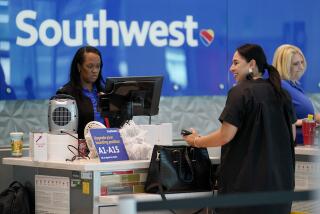Atlantic Air Fare War Is Just Beginning
- Share via
LONDON — After a slow start, an air fare war seems to be developing over the North Atlantic, although the real battle for the market has yet to begin, aviation analysts say.
U.S. and European airlines have been slashing fall season fares since mid-August, but so far the cuts have been confined to economy class, the least profitable part of the aircraft.
Only if business and first-class prices tumble will a serious struggle develop. But airlines, particularly in Europe, have been reluctant to take the gloves off, fearing the damage it would do to already hard-pressed finances.
“There’s no doubt there is going to be a substantial fare war, but the fare war that matters is the one in business class,” said Christopher Will, European airlines analyst at financial house Lehman Bros.
Prices began falling Aug. 12, when British Airways announced price cuts of 15% for transatlantic flights between Oct. 15 and Dec. 13.
Within days, Virgin Atlantic Airways replied with a 25% cut. That was followed by cuts at a stream of U.S. airlines. Some, including Northwest and Delta, trimmed prices by up to 50%.
Competition has been warming up for two reasons--the arrival this year of larger and more efficient U.S. airlines on highly profitable North Atlantic routes and the need to overcome a fall in traffic due to the recession.
Last March the British government approved the entry into London’s Heathrow airport of the world’s two biggest carriers, AMR Corp.’s American Airlines and UAL Corp.’s United Airlines, in place of Pan Am Corp.’s Pan American World Airways and Trans World Airlines.
Other U.S. airlines have followed, including Delta, the world’s sixth-biggest carrier.
This has caused problems for airlines with established transatlantic routes. The recession in the United States and Britain and the effect of the Gulf War cut passenger traffic by up to 30%.
The end of the Gulf conflict and an improving economic climate has since lifted traffic, but recovery is patchy and some airlines say transatlantic traffic is still down 5% from a year ago.
One method airlines are using to entice more passengers onto their planes is discounts. However, they have to tread a fine line between the need to be competitive on price and the need to make a profit.
Most profit is made on business and first-class seats, so price competition has been confined, for now, to economy seats.
There can be considerable profit on transatlantic flights. Analysts said business-class round-trip fares between London and New York are in the region of $1,350.
Although British Airways and Virgin Atlantic fired the opening shots in the fare war, few major European airlines have joined in.
Swissair-Schweizerische Luftverkehr has no intention of introducing discounts after cutting prices 4% to 6% in April, a spokesman said recently.
Air France has also held fares steady. “Nothing justifies our getting into a price war,” a spokesman said two weeks ago.
KLM Royal Dutch Airlines said last month that it was ready to respond to U.S. competition but has given no details.
Germany’s Lufthansa has cut economy fares.
More to Read
Inside the business of entertainment
The Wide Shot brings you news, analysis and insights on everything from streaming wars to production — and what it all means for the future.
You may occasionally receive promotional content from the Los Angeles Times.










